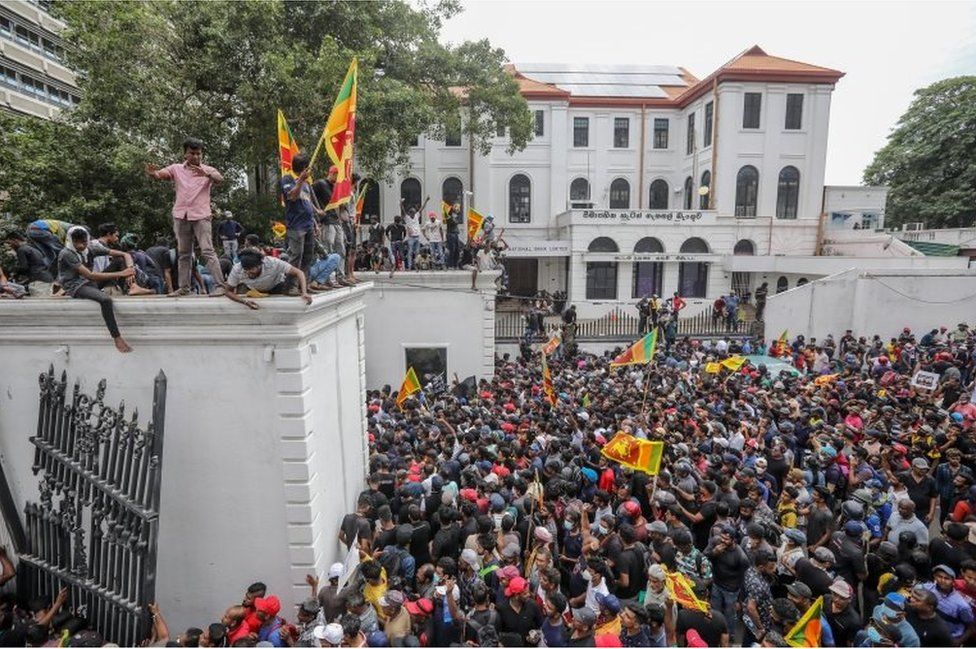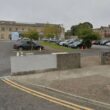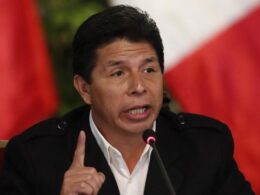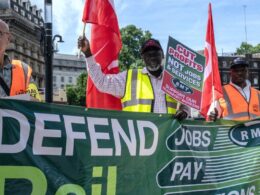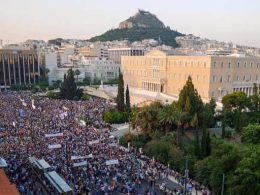By Serge Jordan, International Socialist Alternative
Fast-paced events in crisis-ridden Sri Lanka have taken yet a new turn today, Saturday 9 July, as hundreds of thousands of people descended onto the capital Colombo in a day of huge protests originally initiated by the young activists occupying the central protest site at Galle Face Green. Today’s protest culminated with the mass storming of President Gotabaya Rajapaksa’s official residence, forcing the latter to flee the said Palace minutes before it happened. In the evening, he announced he would step down, enacting what had already been achieved by the masses on the streets. Celebrating firecrackers were heard in many parts of the city at the announcement of this news.
A sense of emotional relief and exaltation will no doubt engulf many Tamil families, in Sri Lanka and abroad, in witnessing the inglorious political end of this blood-soaked dictator responsible for war crimes, tortures and disappearances of Tamils on a genocidal scale. Many autocrats and capitalist rulers around the world, though, will be looking at today’s events in Sri Lanka with a reserved sense of panic, as the island’s economic, social and political storm is offering them a mirror of what will be coming next in many other countries ravaged by the new stage of crisis of global capitalism.
Scenes of hundreds of protesters breaking through several lines of police barricades and forcing their way into the building, waving flags over its roofs and even taking a dip in the President’s swimming pool were largely spread on TV screens around the world. This comes with no real surprise as people in Sri Lanka have endured months of hours-long blackouts and excruciatingly long queues for essentials under heavy heat while a thin layer of corrupt politicians and millionaires, epitomized by Gotabaya himself, have continued to indulge in luxurious lifestyles.
The streets around the Presidential building were occupied by an ocean of protesters, manifesting their rage at the ruling crooks who have thrown the immense majority of the country’s population into an ever-worsening cycle of economic suffering. The lack of available fuel and the resulting ban on private vehicles and near-collapse of public transport did not stop people from traveling from miles around, including from outside Colombo and from remote parts of the country, to make it to today’s protest. In the middle of the afternoon, a correspondent from Al Jazeera reported: “Tens of thousands of Sri Lankans are still streaming into Colombo… People stormed railway stations and literally forced employees to put them on trains and bring them to Colombo. They say they are taking their country back.”
Overwhelmed by the sheer numbers and determination of the protesters, attempts by security, police and army forces to hold back, let alone dislodge the protesting crowd were hopeless. Isolated scenes of state forces sympathizing with and even joining the protest were reported. A video of a police officer parking his motorbike, throwing away his helmet and voicing slogans in support of the demonstration has gone viral on social media.
The police had originally imposed a curfew in the capital and several other cities on Friday night in anticipation of the announced day of protests, but canceled it the next morning following objections by opposition politicians and by the Bar Association of Sri Lanka. Prohibition orders requested by the government against the protest had also been rejected by the High Court. These are sure indications that divisions were widening between different wings of the establishment as to how to respond to the boiling pressure from below, and to what was expected to be a momentous day of struggle.
After today’s events, the US ambassador to Sri Lanka even called on the island’s police to give demonstrators “space”. Sections of the ruling class are worried that a state crackdown at this stage can ignite the flames of revolution —even perhaps provoking splits within the lower ranks of the military and police forces, who are themselves submitted to the ruinous economic policies of the rotten and discredited regime they are officially meant to protect.
Resignations
In the aftermath of these explosive developments, Prime Minister Ranil Wickremesinghe, who had himself been moved to a secure and undisclosed location, was the first to formally announce his resignation. Wickremesinghe had been handpicked by the hated President less than two months ago to replace the latter’s elder brother, Mahinda, who had been ousted following a similar, explosive bout of mass action. This is thus the second Prime Minister to be overthrown by the popular uprising, which erupted earlier this year in reaction to the ongoing economic collapse gripping the island.
The ruling class’ half-hearted hope that the appointment of Wickremesinghe would allow for the mass resistance to be subdued and for its savage austerity plans to roll over unopposed have been given today a formidable response. Incidentally, the ex-Prime Minister’s private residence has itself been set ablaze by protesters. Under Wickremesinghe’s charge, the crisis only went from bad to worse, and it was only a matter of time before a new breaking point would be reached.
Immediately after the storming of Gotabaya’s residence, at least 16 MP’s of his own Sri Lanka Podujana Peramuna party (SLPP) had already requested his immediate resignation, in a desperate bid to distance themselves from a leader they had supported until the last minute. Summing up the mood among the ruling circles, a former adviser to the Rajapaksa’s declared, “In a way, the president has already gone, it doesn’t matter what he says — he’s now become irrelevant”. A few hours after the chief of government’s resignation, Gotabaya’s intention to quit power “by next week” was publicly announced by the voice of Parliament Speaker Mahinda Yapa Abeywardena. At the time of writing this article, the whereabouts of Gotabaya himself are still unknown, although video footage has shown him hastily embarking on a navy ship with parts of his family.
For a movement whose clearest demand was captured in the popular slogan “Gota go home” and the need to overthrow the President, the burning question has now shifted to what will and should come next. All efforts of the main opposition parties are directed towards cobbling together a so-called unity or “all-party” government. The truth, however, is that the anger of the masses in Sri Lanka goes much beyond the Rajapaksa clan; for many, it is the whole political establishment and the system behind it that needs to be put on the dock. This is entirely justified considering none of the parliamentary opposition parties have advocated a fundamentally different economic path to the one followed by the Rajapakasa’s and their successive governments, none of them —whether the Samagi Jana Balawegaya (SJB), the Janatha Vimukthi Peramuna (JVP) or the Tamil National Alliance (TNA)— have objected in principle to the central strategy pursued by the outgoing cabinet of begging for more money from the IMF in exchange for a ruthlessly pro-austerity programme slashing working and poor people’s lives even further than they have been already.
The youth, working class and impoverished masses of Sri Lanka have today demonstrated tremendous revolutionary energy and potential, as they have for months on end despite the extreme hardships daily imposed on their shoulders. They have shown once again that it is their own mass mobilization and organization, and nothing else, that can force the ruling class to cave in. They need now not to end but to step up their fight. The rock-solid strength displayed by the general strike and ‘Hartal’ (total shutdown) in April and May has shown that the trade unions and the working class generally have a decisive role to play in bringing about such an escalation.
But the masses also need to develop their own revolutionary alternative —rather than let a bunch of pro-capitalist politicians with no mandate from the movement hijack their struggle and decide it all for them. This can be prepared by the building of an island-wide network of grassroots committees of action in the workplaces, universities, towns and villages, as the core organizational axis around which a future government made up of representatives of the working class and revolutionary people could see the light of day. Through such committees a revolutionary Constituent Assembly could be democratically elected that dynamically reflect the innermost aspirations of workers, poor farmers, revolutionary youth and all the diverse and oppressed sections of the population of Sri Lanka, and is responsible to them. It would start by discarding the authoritarian and chauvinist, Sinhala buddhist-centered constitution, and debate the measures needed to achieve a decisive move away from the current bankrupt political and economic system.
Mass self-defense should also be consciously prepared for because the danger of bloodier repression, or even of a military takeover, has not disappeared. Explicit appeals for class solidarity should be aimed at rank-and-file soldiers and police, urging them to not use force against the people’s movement.
In the forging of a clearer direction to the movement and in the renewed discussions that are likely to emerge on what a post-Rajapaksa future should look like, no difficult question should be avoided —including over the necessary recognition of the terribly oppressive and brutal treatment inflicted by the disgraced regime on the Tamil people and over the necessary incorporation of the latter’s demands for war reparations, equal rights and genuine self-determination. Chief of Defense Staff General Shavendra Silva’ recent summon to all citizens to “support the armed forces and the police” partially reflects the nervousness of the army top brass that their bloody past, corruption dealings and tight association with the Rajapaksa’s could now be open to public scrutiny — and they should. Beyond the Rajapaksa themselves, all the criminals serving in or retired from the army responsible for war atrocities should be brought to justice, and the building of a mass struggle to end the military occupation of the Tamil north and east should be encouraged. The hugely bloated military budget should be scrapped and resources reinvested for social use. These and similar demands are crucial to root the unity between Tamil and Sinhalese workers and youth on solid grounds.
Today’s storming of the Presidential residence by the masses in Colombo has opened up a new chapter in the revolutionary uprising in Sri Lanka, and the significance of these events will be felt on an international scale. A new victory has been snatched as the figurehead of a corrupt, authoritarian and chauvinist regime has been shown the exit door. But huge challenges are still lying ahead as all the economic problems facing the Sri Lankans are still there; and none of them can be solved within national and capitalist boundaries.
Starting with emergency measures such as the uncompromising repudiation of any debt repayment to rapacious international creditors, price caps on all essential items, public control over capital flows and the immediate expropriation of the wealth of the Rajapaksa family, the mass movement needs to equip itself with a coherent program of demands that fundamentally questions the profit-seeking logic of the capitalist system nationally and internationally, and that advocates for the working class to take over the production and distribution of the main economic activities on the island for the purpose of democratic, socialist planning. Crucially, the masses will also need to build their own party to further that goal. Placing no trust in any foreign powers and their institutions —who are guided only by their own economic and geopolitical interests— they should instead appeal for support and emulation from the workers and poor in South Asia and across the world, who are themselves hammered by the global food and energy crisis and will find a tremendous source of inspiration in the mass uprising rocking Sri Lanka.





